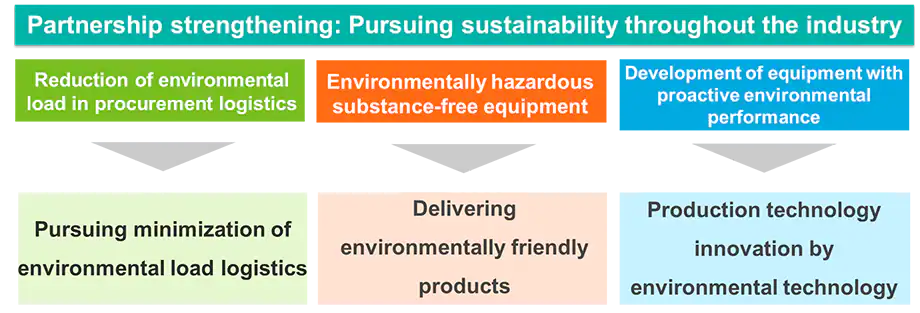Environment
Our Approach to the Environment
Tokyo Electron aims to solve environmental issues through our leading-edge technology and services under the slogan of "Technology for Eco Life." We strive to contribute to the establishment of a sustainable society by reducing our impact on the consumption of resources, on biodiversity, and on climate change by taking actions that both directly and indirectly contribute to the protection and conservation of the environment.
September 25, 1998 Established
July 1, 2016 Revised
- Environmental Goals and Continuous Improvement
- We establish environmental goals and continual improvement of the environmental management system to enhance environmental performance throughout our product lifecycle.
- Compliance with Applicable Laws
- We continually enhance our knowledge of environmental issues to not only comply with applicable laws, but also set additional voluntary standards.
- Environmental Contribution with Product
- We develop environmentally complimentary products through our leading-edge technology. TEL cooperates with our customers and suppliers to strive for the prevention and improvement of environmental impacts to contribute to a sustainable society.
- Operational Environmental Impact Reduction and Preservation
- We quantitatively analyze and reduce the environmental impact of TEL global operations, with activity from all levels of employees and operations to prevent pollution and protect the environment.
- Collaboration and Cooperation with Stakeholders and Society
- We actively promote collaboration and cooperation with all our stakeholders to achieve mutual understanding and conformance to expectations.
Based on the above-mentioned policy, we strive to reduce the environmental impacts on the entire value chain of the product lifecycle (planning, development, designing, procurement, manufacturing, logistics, use by customers, maintenance services, and disposal of products). In addition, the lifecycle of our products covers the time they are at suppliers we procure from, contractors used for development, manufacturing, and logistics, and customers the products have an environmental impact at. We strive to conduct due diligence by grasping potential environmental risks when we engage in M&A or newly enter projects. The above-mentioned policy is being implemented based on decisions made by the CEO and corporate directors in charge acting as highest decision-makers, and decisions are reflected onto management.
Environmental measures are growing even more crucial. We have established an Environment Promotion Department in our headquarters, headed by our corporate director in charge of the environment. This department oversees multiple boards to promote efforts to address medium- to long-term environmental issues throughout entire Group. We also issue reports on the state of progress of these initiatives to management, including the CEO, through the framework of councils set out in Table 1.
In accordance with the ISO 14001 certification that the entire Group (mainly our manufacturing subsidiaries) obtained in March 2017, we have identified environmental impact assessments and useful environmental aspects within this standard, and are executing a standardized group format for environmental management programs and internal audit checklists. To ensure compliance with the environmental laws and regulations of various countries, which undergo frequent revisions, we are making efforts to gather information regarding PFAS*-related regulations at earlier stages and taking a proactive stance towards compliance. We were once again free from environmental incidents, violations and legal proceedings in fiscal year 2024.
*PFAS: Per and Poly Fluoroalkyl Substances. This is the collective term for perfluoroalkyl and polyfluoroalkyl compounds, a subset of organic fluorine compounds.
| Conference Name | Participants | Function | Meeting Frequency |
|---|---|---|---|
| Council for the Regular Reporting of Environmental Activities | CEO, Corporate Officer, manufacturing companies president, corporate director in charge of the environment | Report on matters discussed at the Global Environment Council and the TEL Corporate Environment Council and review items for approval | Quarterly |
| Manufacturing Companies Presidents’ Council* | Manufacturing companies president, corporate director in charge of the environment, etc. | Monitor and supervise progress related to environmental issues | Quarterly |
| TEL Corporate Environment Council | The GMs in charge of the environment and vice presidents of department, etc. | The promotion of environmental activities across the entire Group, set Group-wide goals | Appropriately |
| Global Environment Council | Appointed members by the executives at headquarters and the Group companies | Set individual goals related to environmental issues, monitor progress, work to achieve our goals | Twice annually |
At the Manufacturing Companies Presidents’ Council, information is shared on business affairs and issues regarding environment, safety, quality, supply chain management, etc.
ISO 14001:2015 Certified Plants and Offices
| Company Name | Plant/Office name | Certification Number | Certification Date | Update Date |
|---|---|---|---|---|
| Tokyo Electron | Environment Promotion Department (Fuchu Technology Center) | 1124-1998 -AE-KOB-RvA | May 1998 | Mar. 2023 |
| Tokyo Electron Technology Solutions | Fujii Office/Hosaka Office/Tohoku Office | |||
| Tokyo Electron Kyushu | Koshi/Ozu Office | |||
| Tokyo Electron Miyagi | Taiwa Office | |||
| Tokyo Electron(Kunshan) | — | 130755-2013-AE-RGC-RvA | Mar. 2013 | Mar. 2022 |
| TEL Manufacturing and Engineering of America | Chaska Office, North Chelmsford Office |
EMS586278 | Mar.2013 | Feb. 2022 |
| Tokyo Electron Korea | TEL Technology Center Korea, Balan Plant | ESC2795 | July 2014 | Aug. 2023 |
E-COMPASS
As an industry leader in the domain of environmental management company, we rolling out E-COMPASS (Environmental Co-Creation by Material, Process and Subcomponent Solutions) , our environment-focused initiative.. Through E-COMPASS, we will work together with our customers and partner companies to preserve the global environment by promoting technological innovation and aiming to reduce the environmental impact of semiconductors throughout the entire supply chain, centering on the three following perspectives.
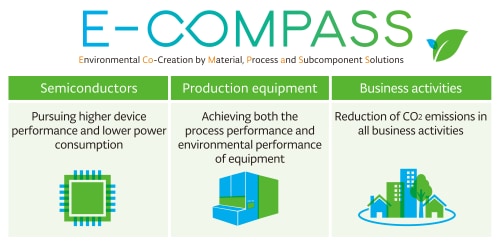
- Pursuing higher performance and lower consumption in semiconductors
- Achievement of both process performance and environmental performance of equipment
- Reducing of CO₂ emissions in all business activities
Environmental Risks and Opportunities
Various environmental issues affect our daily lives and corporate activities. Physical risks, such as rising average global temperatures, strong winds, disasters and water shortages caused by climate change and abnormal weather, are expected to damage assets, increase operating costs and impact the supply chain. In addition, legal risks including stronger environmental laws and regulations, more stringent regulations on greenhouse gas emissions and the introduction of carbon taxes are expected to lead to higher costs for associated measures.
At the same time, promoting environmental initiatives leads to more opportunities to sell environmentally friendly products and reduce operating costs. We also recognize that providing high-value-added products that contribute to higher performance and lower power consumption of semiconductors and FPDs leads to the building of an energy-saving society that makes the most of information technology, and thus provides an opportunity to improve corporate value.
Based on the requirements of ISO 14001, we identified and analyzed internal and external issues in relation to the environment, namely, our relationship with the climate, air quality and water quality. We also clarified the environmental needs and expectations of customers, suppliers, governments and employees and identified our compliance obligations as an organization. In addition, we define risks and opportunities to address as: (1) environmental management by reducing the environmental impact of our business activities, (2) compliance with applicable laws and (3) enhancing product competitiveness with the environmental contribution of products.
In addition, we are also considering risks and opportunities that are expected to occur due to the impact of climate change based on recommendations of the TCFD.
TCFD
Initiatives Related to Recommendations of the Task Force on Climate-related Financial Disclosures (TCFD)
Based on the TCFD recommendations, we examine the risks and opportunities that climate change poses to our business and take various response measures as we endeavor to make disclosures high in transparency. In fiscal year 2024, we are considering the contents of IFRS S2* and are disclosing them to the extent possible.
In addition, we moved the net zero goals ahead of schedule from 2050 to 2040 and are actively pursuing initiatives to attain these goals.
IFRS S2: International Financial Reporting Standards (IFRS) Sustainability Standards of Disclosure S2 Climate-related disclosures
Status of Initiatives Related to Recommendations of the TCFD
| Items | Contents | |
|---|---|---|
|
Governance
|
|
|
| Strategy |
|
|
| Risk Management |
|
|
| Metrics and Targets |
|
|
Refer to Risk Management
Refer to E-COMPASS, Initiatives with Suppliers (E-COMPASS)
Refer to Environmental Goals and State of Progress
Anticipated Risks and Opportunities of Climate Change Impact and Our Response
- Timeline: Short-term = five years or less; medium-term = 2030; long-term = 2050
- Scenarios used: 1.5˚C scenario (1.5˚C temperature increase), 4˚C scenario (4˚C temperature increase)
- Scope: The entire Group as well as the entire value chain including upstream and downstream
| Type (Scenario) |
Risk or Opportunity Items | Timeline of Risk Manifestation | Anticipated Risks or Opportunities | Impact on Tokyo Electron | Risk Evaluation*¹ | Our Response |
|---|---|---|---|---|---|---|
| Transition Risks (1.5°C scenario) |
|
Short- to medium-term |
|
|
Low |
|
|
Short- to long-term |
|
|
Low~ High |
|
|
| Physical Risks (4°C scenario) |
|
Short- to medium-term |
|
|
High |
|
|
Medium- to long-term |
|
|
Low |
|
|
| Opportunities (Common) |
|
Short- to medium-term |
|
|
High | |
|
Medium- to long-term |
|
|
Middle~ High |
||
|
|
Risk evaluation: Sets out the findings of evaluations of the impact of risks or opportunities within Tokyo Electron.
Carbon tax: We referred to the International Energy Agency (IEA) Net Zero Emissions by 2050 Scenario for the increase in tax associated with GHG emissions. 1 U.S. dollar was converted as 145 yen.
Suppliers’ BCP assessments: Surveys have been conducted since fiscal year 2014 for suppliers accounting for more than 80% of our procurement spend (more than 85% of our procurement spend from fiscal year 2023).
CO₂ Emissions Across the Value Chain
Based on our slogan “Technology for Eco Life,” we aim to resolve environmental problems through leading technology and reliable services, understand the environmental impact generated throughout our entire value chain and promote business activities to reduce that impact.
Our total CO₂ emissions of Scope 1 and Scope 2 is 43 kilotons, while Scope 3 as the sum of upstream and downstream activities accounts for a total of 11,829 kilotons, 99.6% of the total. Of this, CO₂ emissions when using products stand at 8,068 kilotons, about 70% of the total. This is why we consider the development of products with low CO₂ emissions during operation to be important.
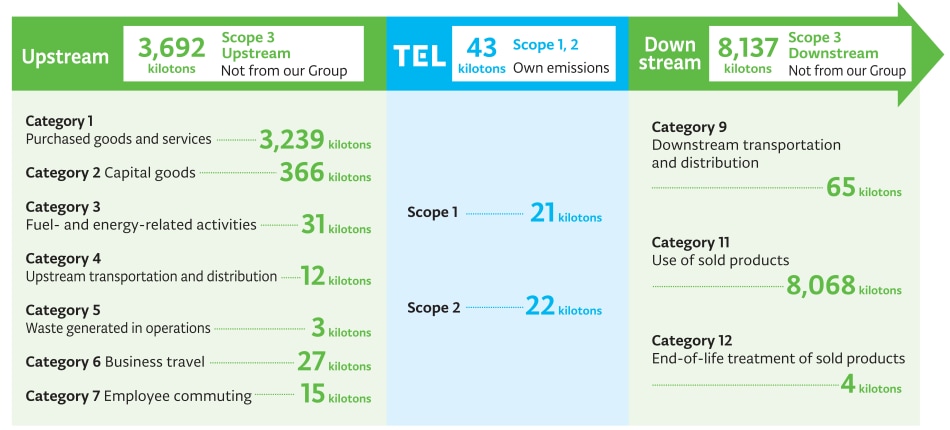
- Scope 1: Direct greenhouse gas (GHG) emissions from use of fuel and gas we owned or controlled
- Scope 2: Indirect GHG emissions from use of electricity, steam and heat we purchased
- Scope 3*: Emissions from corporate value chains (excluding Scope 1 and 2 emissions), such as product transportation, employee business travel and major outsourced production processes
Scope 3 is divided into upstream activities, which include emissions associated with purchased or procured products and services, and downstream activities, which include emissions associated with sold products and services.
Environmental Goals and Progress
In December 2023, we moved up the target year of our net zero*¹ target for 2050 by a decade, to 2040. We recognize dealing with climate change as a pressing global issue. We will implement various new measures, based on newly set targets. Through this, we will strive to protect the environment and actively lead efforts to achieve net zero emissions as a company of global excellence.
In October 2023, we received SBT*² certification, recognizing that the greenhouse gas reduction targets we had set for 2030 were scientifically based.
Achievement of net zero greenhouse gas emissions from Group activities (Scopes 1 & 2) and from activities outside the Group (Scope 3) by 2040
SBT: Science Based Targets. SBTs are targets that are set by companies for 5 to 15 years in the future and that match the standards required by the Paris Agreement.
|
Targets recognized as SBTs
|
|
|---|
Initiatives Concerning Own Emissions (Scope 1 and 2)
We aim to cut total CO₂ emissions from plants and offices by 70% (compared to fiscal year 2019 levels) and use renewable energy for 100% of our power by fiscal year 2031. By fiscal year 2041, we plan to achieve net zero emissions. The ratio of renewable energy used in all companies in fiscal year
2024 was 90%, which reduced CO₂ emissions by 75% compared with the amount in the reference fiscal year. As a result of this, and assisted also by energy-saving activities, we have reduced total CO₂ emissions from our plants and offices by 75%, enabling us to reach our target ahead of schedule.
From fiscal year 2025, we will change our target to a reduction of 85% and further promote initiatives to reduce CO₂ emissions.
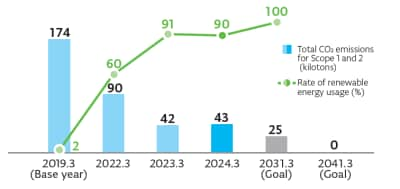
CO₂ emissions reductions from the introduction of renewable energy, etc.
Initiatives Concerning Emissions Not from Our Group (Scope 3)
We aim to reduce CO₂ emissions per wafer by 55% compared to fiscal year 2022 levels by fiscal year 2031. We also seek to achieve net zero emissions by fiscal year 2041. As of fiscal year 2024, we have reduced CO₂ emissions per wafer by 24% compared to the base year.
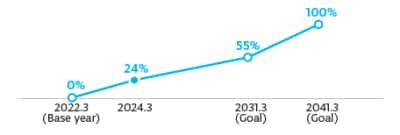
Reduction Rate in CO₂ emissions related to products
Achievement levels of goals
◎Exceeded target 〇Proceeding well △Need to accelerate to achieve the goal
| Item | Scope | Target | Target FY | FY 2024 Results | Evaluation |
|---|---|---|---|---|---|
| Plants and offices |
Total CO₂ emissions | 70% reduction | 2031 | 75% reduction | ◎ |
| Renewable energy (electricity) | 100% | 2031 | 90% | ○ | |
| Energy consumption (per-unit basis) | 1% year-on-year reduction | Maintain each year | Achieved by 2 out of 11 plants and offices | △ | |
| Water consumption (per-unit basis) | Maintain base year level | Maintain each year | Achieved 10 out of 13 targets | 〇 | |
| Products | CO2 emissions per wafer | 55% reduction | 2031 | 24% reduction | ◎ |
| Logistics | CO₂ emissions | 30% reduction | 2027 | 18.4% reduction | 〇 |
| Switch from wooden crates to STW* | 50% | 2024 | 22.4% over full year period (26.4% in fourth quarter) | △ (Extended to fiscal year 2025) |
STW: Strong Triple Wall. Reinforced cardboard made up of three layers.
Based on the roadmap for products to achieve the goals, for each product we calculated the reduction in consumption of electricity, process gases and chemicals, water, and other resources depending on how much of the above are consumed when the relevant product is manufactured or used, effects of the reduction in consumption of these resources, and the reduction in consumption due to improved productivity. In October 2023, we have received the certification from the SBT initiative* for our greenhouse gas emission reduction targets set for 2030 (Scope 1,2 and 3). We will continue to work as one company-wide on initiatives aimed at achieving net zero by fiscal year 2041.
Science Based Targets initiative(SBTi): The Paris Agreement aims to limit global warming to well below 2°C, preferably to 1.5°C, compared to pre-industrial levels. SBTi is an international initiative to certify greenhouse gas emission reduction targets set by companies for the next five to 15 years, consistent with the levels required by the Paris Agreement.
Progress in related initiative
- Reduction of water consumption: Initiatives to Conserve Water Resources and Reduce Water Consumption
- Reduction of waste: Initiatives to Reduce Waste
- Management of toxic substance emissions: Management of Chemical Substances, Initiatives for Product Environmental Laws and Regulations
Product Initiatives
Products that Contribute to a Sustainable Society
Of the CO₂ emissions from our value chain, emissions during product use account for about 70%. We believe that the low energy consumption of products is important as part of our social responsibility as a semiconductor production equipment manufacturer and are working on environmentally friendly product design.
One of our SBTs is to reduce Scope 3 greenhouse gas emissions from the use of the products we sell by 55% per wafer by fiscal year 2031 (in comparison to fiscal year 2022). In fiscal year 2024, to work towards achieving this target, we calculated figures for the base year of fiscal year 2022 and simulated results for the years leading to fiscal year 2031. O ur actual reduction for fiscal year 2024 was 24%.
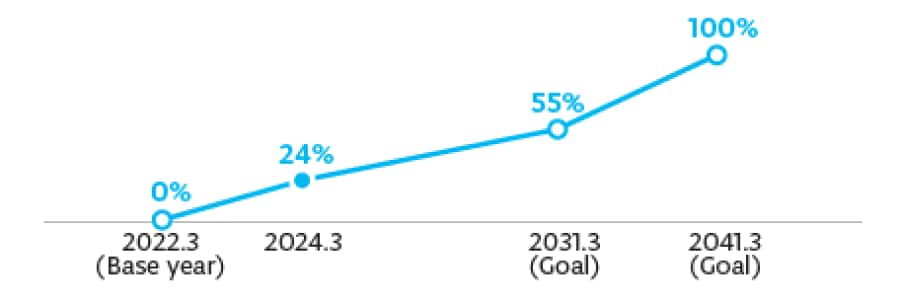
In addition, we use the Green Transformation (GX) Monitor, which captures information on energy use including electricity, water and nitrogen, as well as equipment operating status, and turns it into a database, to visualize energy consumption information during product use. Specifically, we have introduced a system that allows us to check equipment operating status and energy consumption information in chronological order through our intranet, and are planning to expand the scope of this system going forward.
We will continue to work to further raise environmental awareness and incorporate environmental technologies as important added value in our technological strategies, thus contributing to the reduction of the environmental impact of society as a whole.
Example Initiative1
In order to achieve the mid-term environmental goals for fiscal year 2031, we are developing and employing energy-saving accessories, improving the productivity of equipment through high-throughput*, and reducing consumption of utilities via flow rate control. Furthermore, we are also actively implementing activities such as enhancing the yields of product parts, increasing the lengths of maintenance cycles, stabilizing operations, and reducing footprints that indirectly contribute to reductions of CO₂ emissions and environmental loads.
In fiscal year 2024, we are promoting the development of devices with high levels of environmental performance that leverage our technologies, such as etch technologies for 3D NAND use that are exceptionally fast yet an 84% lower global warming potential and laser separation technologies that contribute to technological innovation in state-of-the-art 3D device mounting and require no pure water for laser processing.
throughput : the capacity of processing wafers during a certain length of time
Example Initiative 2
To achieve our target of net zero emissions, we believe it is important to reduce greenhouse gas emissions across the entire supply chain. To do that, we must assess the emissions from each product (their carbon footprint, or CFP). This is an area of growing interest for our customers.
We conducted a CFP study of our suppliers in fiscal year 2024. This study covered their net zero targets, their CFP investigations and level of understanding, their collection of information from their own suppliers and the status of their information collection and other issues and concerns. Through our study, we were able to confirm information regarding CFPs and the methods used to investigate and calculate them, along with human resource-related issues. We shared our opinions with suppliers on a one-on-one basis and deliberated with them about how to determine their CFPs. Semiconductor production equipment is made up of numerous materials and components, so identifying the CFPs of each component presents a formidable challenge, but we will continue to work toward this goal with the cooperation of our suppliers.
Initiatives for Product Environmental Laws and Regulations
In order to comply with each country’s environmental laws and regulations pertaining to products, we promptly collect information and promote proactive responses. For example, we provide our suppliers with information on US TSCA*¹ that will prohibit PIP(3:1)*² from being included in and after November 2024 in order to prompt them to ensure that the substance will not be included in their products, or to use alternative substances. In addition, we have been introducing the chemSHERPA*³ format since fiscal year 2021 and collected information from suppliers on chemical substances in concentrations in the parts per billion (ppb*⁴). As a response toward GHS*⁵ requirements, we provide the necessary safety data sheets (SDS*⁶) and labels when supplying chemical products to customers, in addition to promoting the local procurement of chemical products.
To comply with the frequently revised environmental laws and regulations, we continue to offer “Product Environment Compliance” training to all employees, and provide suppliers with information related to the relevant environmental laws and regulations.
We will continue to grasp each country’s environmental laws and regulations rapidly and strive to respond appropriately.
US TSCA: The Toxic Substances Control Act
PIP(3:1): Phenol, isopropyl phosphate (3:1)
chemSHERPA: A data entry support tool for appropriately communicating information on chemical substances in products across the entire supply chain, and a common system for communicating information on chemical substances contained in products
ppb: parts per billion (1×10-9)
GHS: Globally Harmonized System of Classification and Labelling of Chemicals
SDS: Safety Data Sheet. Refers to the document containing hazard information about chemical substances that is issued when a company transfers or provides chemical substances, or products containing chemical substances, to another company
Product Reuse and Recycling
Semiconductors are in greater demand and are becoming more diverse than ever. This has driven a corresponding rise in the need for more varied semiconductor production equipment. As a leading manufacturer of semiconductor equipment, we are strongly encouraging reuse and recycling of equipment and components by marketing refurbished TEL equipment and offering modification services to customers who already have our equipment installed.
Our refurbished equipment operations start with procuring used equipment from the market, which takes place either directly or through leasing companies. This equipment is then properly tested and refurbished, before being offered to customers as our Certified Used Equipment.
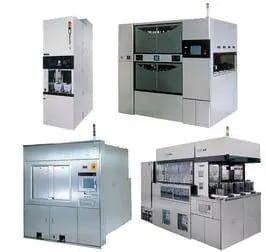
Plant and Office Initiatives
Introducing Renewable Energy
We have set medium-term environmental goals of total CO₂ emissions at plants and offices by 70% (compared with fiscal year 2019) and rate of 100% renewable energy (electricity) usage at plants and offices by fiscal year 2031. The ratio of renewable energy used in all companies in fiscal year 2023 was 90%, which reduced CO₂ emissions by 75% compared with the amount in the reference fiscal year. This enabled us to achieve the goal of reducing total CO₂ emissions from plants and offices by 70% (compared with fiscal year 2019) ahead of the scheduled fiscal year of 2031.
In fiscal year 2025, we have changed our environmental target to be reducing total CO₂ emissions from plants and offices by 85% by fiscal year 2031 (in comparison to fiscal year 2019).
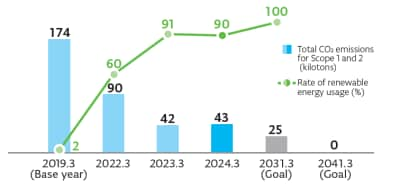
CO₂ emissions reductions from the introduction of renewable energy, etc.
In Japan, all manufacturing sites, plants and offices including tenants began introducing renewable energy in fiscal year 2023. In fiscal year 2024, we expanded these efforts to include introducing renewable energy in the U.S. as well. Through this, we have now completed the introduction of renewable energy at all of our sites in Japan, the U.S. and China. We plan to introduce the system at more overseas offices in the future.
Example initiative
At Tokyo Electron Miyagi (Taiwa), monitors displaying the energy profile of renewable energy generated from solar panels have been set up at the entrance to the plant. At Tokyo Electron Kyushu (Koshi), renewable energy generation initiatives are being promoted, such as the sale of generated energy. In fiscal year 2024, a total of 3,901 MWh of renewable energy was generated in Japan.
Initiatives to Prevent Global Warming and Save Energy
We have brought in a number of initiatives to achieve our medium-term environmental goal at plants and offices, including energy-saving cleanroom operation, setting office air-conditioning at appropriate temperatures, introducing devices that offer superior energy-saving performance and bringing in renewable energy.
Specifically, we are analyzing hourly and seasonal energy usage trends, usage efficiency and more, and we are identifying buildings, equipment and processes with especially high energy usage levels. We are also deliberating and implementing measures for cutting energy usage and for using energy more efficiently.
While we are still reaping the benefits of introducing renewable energy in Japan, the U.S. and China in fiscal year 2024, the amount of power being consumed in sites which do not use renewable energy is rising, and the CO₂*¹ emitted by our energy sources1 was 34 kilotons (a 7.6% increase year-on-year). Our power consumption was 436 GWh (an 8% increase year on year) due to the launch of operations in a new building and an increase in the amount of energy used by product development evaluation.
From fiscal year 2019, we revised*² and shared the per-unit basis for plants and offices in Japan to more appropriate levels based on the correlation between business operations and energy. In fiscal 2024, we achieved our annual targets for per-unit energy sustainability at two of our 11 total plants and offices in Japan and overseas.
The emission coefficient for power consumption in Japan in fiscal year 2023 uses the post-adjustment emission coefficient on a per-electricity supplier basis, while the emission coefficients for power consumption overseas uses the emission coefficients in Emissions Factors 2019 edition issued by the International Energy Agency (IEA).
The per-unit basis is calculated by compound weighting using data on the number of development and evaluation machines, production volume, floor space, and man-hours in each region.
Energy Consumption and Energy Consumption per Net Sales
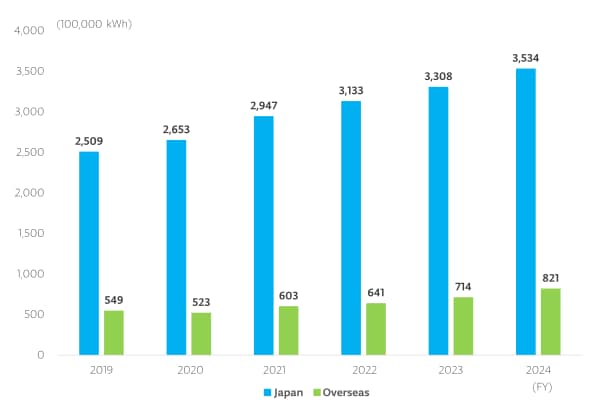
Example initiative 1
The introduction of a system to visualize clearly how much energy is saved at our plants and offices was completed at our major manufacturing sites in Japan in fiscal year 2022. Previously, energy consumption data had to be manually extracted and changes graphed by hand, but integrated management on the cloud has made it possible to check changes at any time. This has made it easier to check the deployment and effects of BKM* at each plant as well as study or implement measures.
More concretely, while in the past we were able to monitor increases and decreases in power consumption for entire business sites and buildings, now we are able to check increases and decreases for each piece of equipment such as refrigeration units, compressors, and lighting, making it easier to analyze and clarify the causes of increases and decreases in usage. In addition, this visualization system has made it possible to compare the effects of capital investment for energy conservation with pre-investment data for a more accurate understanding of the effects. We will accelerate our energy-conservation activities related to operations.
BKM: Best Known Method
Example initiative 2
Tokyo Electron BP holds Energy Conservation Competitions in which employees at each site are encouraged to offer ideas for achieving "net zero" (both Scope 1, 2 and 3 emissions and water resource usage) that are feasible within three years. Excellent proposals are announced, reviewed and publicly recognized. In fiscal year 2024, the fifth competition was held and "Shutdown of Unnecessary Existing Facilities" presented by Tokyo Electron Technology Solutions (Hosaka) won the top prize. It is expected that annual CO₂ emissions will be reduced by 123 tons when this idea is put into practice. These Energy Conservation Competitions provide us with new ideas about how to conserve energy and resources, and we will continue these activities in the future.
Initiatives to Conserve Water Resources and Reduce Water Consumption
With the growing importance of water resource preservation, we use WRI Aqueduct* and freshwater resource quantity indicators to conduct water risk assessments in Japan and overseas. In addition, we confirm the status of water resource use in the supply chain, rainwater and wastewater management and goal setting with suppliers once a year.
To achieve these goals , we analyze hourly and seasonal water usage trends, water usage efficiency and the like. We identify buildings, processes and equipment with particularly high water usage rates and consider and implement measures for reducing water usage and improving energy usage efficiency. Specifically, we are carrying out initiatives for cutting water usage such as reusing pure water from our manufacturing operations, installing water-saving devices for domestic water, watering lawns with rainwater, implementing the intermittent operation of cafeteria faucets and reusing runoff in combustion-based exhaust abatement systems.
We are also performing regular water quality studies to prevent any impact on our development or production processes. Water discharge is treated using water treatment facilities and then is confirmed to fall below legal and regulatory limits before being discharged.
In fiscal 2024, due to an increase in usage resulting from launching operations in a new building and performing product development evaluation, the amount of water we used rose by 3% year on year to 1,542,000 m³. Water consumption per net sales also increased 23% year on year, but we achieved our targets at 10 of our 13 plants and offices in Japan and overseas.
WRI Aqueduct: A water risk assessment tool developed by the World Resources Institute
Water Consumption and Water Consumption per Net Sales
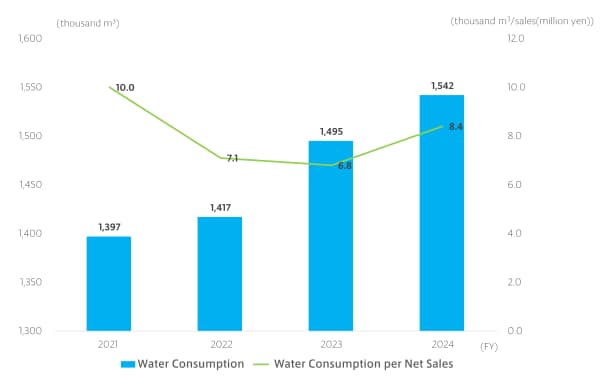
Example initiative
At Tokyo Electron Kyushu (Koshi Office), rejected water* from purified water production is recycled to replenish cooling tower water. This is expected to reduce annual water consumption by roughly 14,000 ㎥.
Water containing a high concentration of impurities produced when separating impurities from water
Initiatives to Reduce Waste
To reduce waste, we are striving to curb the amount of waste we generate and to recycle waste. In addition to using an electronic manifest system*¹ to properly manage waste, we are confirming statistical data regarding waste and performing on-site equipment confirmation to assess waste production trends and their causes. We are identifying buildings, processes and equipment which generate particularly large amounts of waste and implementing measures to reduce the waste they generate. These measures include separating waste and adding new processes. Specifically, to raise recycling rates and cut the amount of waste, we are thoroughly separating waste, thoroughly preventing the wasting of resources, rationalizing parts inventories, using reusable boxes for deliveries, reusing cushioning material and contracting with waste operators capable of performing recycling. Through these efforts we are reducing the amount of waste that is sent to landfills or incinerated without recovering energy. We are also renovating our waste storage sites to increase their capacity while reducing the frequency of collection. Through this, we are striving to not only cut waste processing costs but also to reduce environmental impact.
Through these efforts, in fiscal year 2024 we produced 234 tons of waste to be incinerated without recovering energy or buried in a landfill and achieved a recycling rate*² of 98.8%. This marked the 18th consecutive year, starting in fiscal year 2007, that we have met our target of a recycling rate of 97% or above. We also maintained a high recycling rate at our overseas sites of 92.9%.
Electronic manifest system: A system in which, instead of using printed manifests to manage industrial waste, the flow of industrial waste products is managed through a communications network that connects information processing centers, waste generating enterprises, waste collection enterprises and waste disposal enterprises
Recycling rate: (Recycled amount/Amount of waste generated) × 100
Example initiative
At Tokyo Electron Kyushu, pallets that are partly made from ocean-bound plastics (recycled plastics known as OBPs) are used to store products in stock. Environmental issues related to plastic waste have been drawing attention in recent years. In particular, marine plastic waste is posing serious problems. OBPs, which are plastic waste disposed of in land areas within 50 km from the sea may, if left uncollected, flow into the sea as marine plastic waste and contaminate the environment. We use pallets made from OBP to help combat the problem of ocean pollution.
Management of Chemical Substances
We constantly monitor and manage our use and release of any chemical substances used in product development and manufacturing subject to the Japanese PRTR* law. Whenever we introduce a new chemical substance or change the way an existing substance is used, we check for environmental, health and safety risks beforehand and conduct appropriate processing after use such as by contracting expert vendors and using in-house processing facilities. In response to the Fluorocarbons Recovery and Destruction Law, we conduct simple checks, regular inspections and so on based on law in an effort to monitor the amounts of fluorocarbons filled and recovered.
PRTR: Pollutant Release and Transfer Register. A framework for tracking, tabulating and disclosing quantitative data on chemical substances that may be hazardous to human health and the ecosystem, including the amounts used and discharged into the environment and the amounts transferred (as part of waste) from the plants and offices
Biodiversity and Forest Conservation (TNFD)
Our business activities are made possible by biodiversity. We recognize that our business activities have some impact on biodiversity, so we work to protect this biodiversity. We set a goal of conducting ecosystem tours or conservation activities at our plants and offices in Japan at least twice a year. In fiscal year 2024, we held a total of 19 such events, with a total of 288 participants.
In fiscal year 2023, we formulated commitments to biodiversity and forest conservation with the approval of the CEO.
These commitments applied to our entire value chain, and at the 3rd TEL E-COMPASS Day, an event held in March 2024 for all of our suppliers, we shared the contents of these commitments and the measures we were conducting in relation to them.

Biodiversity and Forest Conservation Commitments
The benefits of biodiversity are essential for the sustainable development of society. However, human society’s activities are having a major impact on biodiversity.
Through “TEL’s Shared Value,” we are working to resolve social issues through business activities that make use of our expertise. We aim to realize “Net Positive Impact (NPI)”* across our entire value chain through ongoing initiatives to preserve biodiversity. We believe that promoting activities in partnership with our stakeholders will help to boost our corporate value in an ongoing manner. As part of these efforts, we aim to achieve zero deforestation through working proactively to protect forests, which are home to ecosystems comprising numerous organisms and which constitute important CO₂ sinks.
We make a map of biodiversity relationships based on the product life cycle assessments. We promote biodiversity initiatives based on the activity guidelines and the relationship map.
NPI: When loss of the natural environment cannot be avoided and the decision is instead taken to generate gains for the natural environment to offset the losses, ensuring that losses and gains are balanced constitutes “No Net Loss (NNL),” while going beyond this by ensuring that the gains outweigh the losses constitutes “Net Positive Impact (NPI).”
Interrelationship Map of Biodiversity Activities
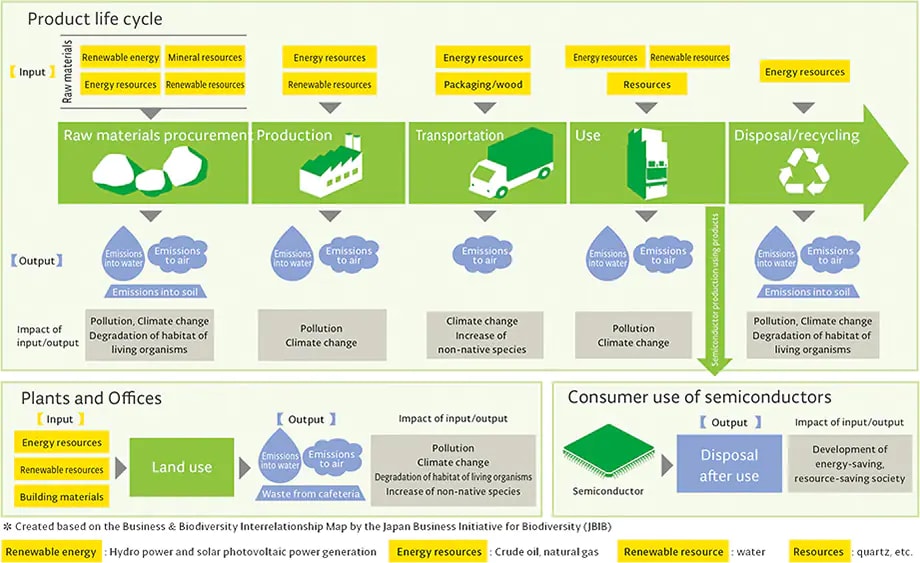
Taskforce on Nature-related Financial Disclosures(TNFD)
Join the Taskforce on Nature-related Financial Disclosures(TNFD) Forum
In July 2023, we announced that we concur with the vision of the Taskforce on Nature-related Financial Disclosures(TNFD)*¹ and has joined the TNFD Forum, a group of institutions that support the activities of the taskforce.
TNFD is an international initiative established in June 2021 to support the transition to a nature-positive*² world, aiming to develop a risk management and disclosure framework for businesses with stakes in natural capital and biodiversity. The TNFD Forum was established in September 2021 as the taskforce’s support organization that provides expert insights and technical assistance to TNFD.
At TEL, we are assessing the impact on nature caused by our business activities and the risks of nature loss, and are working to disclose relevant information in an appropriate manner. We are also collaborating with our stakeholders to enhance natural capital and biodiversity through our entire value chain.
We are assessing the impact of our business activities on nature and the risks the loss of nature poses to our business. We are working to disclose this information in an appropriate manner. We will also collaborate with our stakeholders to enhance natural capital and biodiversity through our entire value chain.
The Taskforce on Nature-related Financial Disclosures (TNFD) was launched in June 2021 with founding members including the United Nations Environment Programme Finance Initiative (UNEP FI), the United Nations Development Programme (UNDP), the World Wide Fund for Nature (WWF), and a British non-profit organization Global Canopy. With the aim of shifting global financial flows away from nature-negative outcomes and toward restoring biodiversity, the taskforce is developing a framework that drives businesses, institutions, and organizations to disclose risks and opportunities impacting natural capital and biodiversity.
Being “nature positive” means putting nature on the path to recovery by stopping and reversing the loss of biodiversity.
TNFD-based reporting
Having confirmed dependencies and impacts on biodiversity of our company’s businesses in fiscal year 2013, we prepared action guidelines to start our biodiversity initiatives. In fiscal year 2023, we formulated the commitments on biodiversity and forest conservation with the approval of the CEO. In fiscal year 2024, we joined the Taskforce on Nature-related Financial Disclosures (TNFD) Forum to understand the basic overview of TNFD and the LEAP* approach that it recommends. Based on this understanding, we investigated the circumstances surrounding our supply chains and identified and compiled the latest information on priority locations . We also interviewed our suppliers to explore the current conditions and outlook concerning sustainability of raw materials. By obtaining information on measures against land use and pollution related to mineral mining, water consumed by manufacturing processes, and commodity production with risks , among others, we assessed the sustainability of raw materials as well as confirmed the current conditions for measures to be taken in the future to identify the traceability of the places of origin of raw materials and the environmental impacts of raw material procurement and to reduce these impacts. Furthermore, we assessed the following risks related to biodiversity.
Locate, Evaluate, Assess, and Prepare: Four steps of risk and opportunity assessment
Biodiversity risk assessment
Impacts and dependencies of our businesses on nature
We analyzed the impacts and dependencies of our supply chains on nature utilizing ENCORE (Exploring Natural Capital Opportunities, Risks and Exposure), provided by Global Canopy, a UK non-profit organization engaging in monitoring of corporate impacts and dependencies on nature, the UN Environment Programme Finance Initiative, and the UN Environment Programme World Conservation Monitoring Centre (UNEP-WCMC) . As a result, we identified that our upstream supply chains have large impacts and dependencies on nature.
|
Supply chain
Upstream
|
Our company |
Supply chain
Downstream
|
||
|---|---|---|---|---|
| Dependencies | Ground/surface water | High | Middle | Middle |
| Climate regulation | High | Low | Low | |
| Impacts | Water use | High | Low | High |
| GHG emissions | High | Low | Middle | |
| Pollutants (Air, water, and soil) | High | Middle | Middle | |
| Solid waste | High | Middle | Middle | |
| Noise/light pollution | High | Middle | Middle |
Risks
- Water risks
We analyzed risks related to water, such as flooding, droughts, and water stress, of each site in and out of Japan utilizing Aqueduct 4.0, provided by the not-for-profit World Resources Institute (WRI). As a result, it was found that our sites in China and the U.K. are located in areas with high water-related risks (Refer to Results of Analyses using Various Tools).
- Biodiversity risks
Concerning the potential impact of our business activities on biodiversity, we surveyed the numbers of IUCN Red List species*¹ and KBAs*² within an approximately 50 km radius from each site in and out of Japan utilizing Integrated Biodiversity Assessment Tool (IBAT), provided by UNEP-WCMC. As a result, we identified that large numbers of threatened species exist around our sites in Taiwan and Singapore.
Our risk analysis using the Biodiversity Risk Filter, provided by World Wildlife Fund (WWF), also revealed that our sites in China have high risks related to water quality, soil, and air quality (Refer to Results of Analyses using Various Tools).
IUCN Red Lis t: List of threatened wildlife species prepared by International Union for Conservation of Nature (IUCN)
Key Biodiversity Area KBA: Key areas for biodiversity conservation
- Deforestation risks
We surveyed the extent of deforestation over the past two decades in the areas where our sites in and out of Japan are located using the Global Forest Watch, provided by WRI, to grasp the forest conservation status. Korea has seen progress in deforestation, compared to other areas, with an approximately 18% decrease in the forest area over the past two decades (Refer to Results of Analyses using Various Tools).
Results of Analyses using Various Tools
| Aqueduct | IBAT | Biodiversity Risk Filter |
Global Forest Watch |
||||
|---|---|---|---|---|---|---|---|
| Water Stress | Water Risk | Water Pollution | IUCN Red list species* | KBAs | Scape Physical Risk | Deforestation Rate | |
| Japan | Middle | Middle | Middle | 1,444 | 7 | Middle | 4% |
| Korea | Middle | Middle | Middle | 926 | 7 | Middle | 18% |
| Taiwan | Middle | Middle | Middle | 3,220 | 5 | Middle | No Data available |
| China | High | High | High | 1,250 | 2 | High | 2% |
| U.S. | Middle | Low | Low | 968 | 2 | Middle | 3% |
| Europe (UK) | High | Middle | Low | 1,000 | 7 | Middle | 3% |
| Singapore | Low | Middle | Low | 3,192 | 7 | Middle | 13% |
Averages for areas with multiple sites.
TNFD Risk Analysis
| Type | Risk | Timeline of Risk Manifestation | Anticipated Risks | Impact on Tokyo Electron | Risk Evaluation | Our Response |
|---|---|---|---|---|---|---|
| Water |
|
Medium- to long-term |
|
|
Middle |
|
|
Medium- to long-term |
|
|
Low | ||
| Minerals |
|
Medium- to long-term |
|
|
Low |
|
|
Short- to long-term |
|
|
Low | ||
| Timber |
|
Medium- to long-term |
|
|
Low |
|
| Land use |
|
Medium- to long-term |
|
|
Low |
|
| Pollution (water quality, soil, solid waste, etc.) |
|
Short- to long-term |
|
|
Low |
|
| Opportunities |
|
Short- to long-term |
|
|
High |
|
|
Short- to long-term |
|
|
Low |
|
CMRT: Conflict Minerals Reporting Template. Survey format for reporting conflict materials, provided by the Responsible Minerals Initiative (RMI), which has established international guidelines on conflict minerals.
3TG: Tantalum, tin, tungsten and gold
As steps toward considering our measures against the water risks identified and specifying our commitments to biodiversity and forest conservation, we are planning to set indicators and action policies, perform detailed surveys of and activities in the surrounding areas of our sites, and engage in management of environmental and social risks related to minerals.
Example initiative
Tokyo Electron Miyagi has named a 4.2 ha area of prefectural forest in Yamato Town "Tokyo Electron Forest" as part of its efforts to nurture forests and preserve the environment, and has been conducting tree-planting activities (tree-planting events) since 2017. A total of 283 participants planted 324 trees in six years. In addition to planting trees and capturing trees, full-scale forest maintenance was carried out, including sorting out depleted trees and moving logs, and the participating children also had the opportunity to climb a cliff using ropes, make wreaths, and experience nature crafts.
In the sixth year of this activity, the forest, which was covered with dead and damaged trees before maintenance, is regaining its original appearance and has become like a park with a walking trail. In addition to the landscape, the number of shrimps, gentians, butterflies, and dragonflies in the ponds and puddles has increased, contributing to biodiversity.
Environmental Communication
Our environmental policy requires that we respond appropriately to the expectations of society. We promote initiatives for the environment while engaging in ongoing communication with all of our stakeholders.
In addition, to better promote environmental communication internally, we provide an environmental program for new employees and mid-career recruits, plus a refresher program for existing employees.
In fiscal year 2024, approximately 12,000 employees in Japan participated in the refresher program for existing employees. This training relates to our efforts to cut energy usage, our renewable energy initiatives, our efforts to reduce water usage and our initiatives for reducing waste and raising recycling rates, helping change employees' mentalities regarding these issues. In fiscal 2025, we will carry out an educational program for suppliers that will provide them with a greater understanding of our environmental policies and goals. Specifically, the training will cover topics such as Tokyo Electron's Environment Policy, our medium- and long-term environmental goals, the importance of environmental and climate change-related measures, abnormal weather and global warming and the methods used to calculate Scope 1, 2 and 3 CO₂ emissions from the supply chain .
Example initiative 1
At Esashi Plant in Iwate, employees participate in activities of "Oshu Megumi Net", a citizens' environmental conference in Oshu City. In fiscal year 2023, they are promoting communication through activities such as delivering a lecture titled "Environmental Activities: Technology for Eco Life" and participating in nature observation activities with local residents.
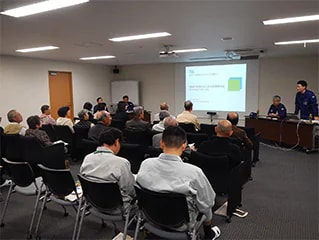
Example initiative 2
As part of our enlightenment activities aimed at providing increased opportunities to consider biodiversity, eco-life, and the environment through taking photos and/or painting pictures, we have been holding the TEL Eco-Life Art and Photo Contest annually since 2009. The contest, which is held for employees and their families, has attracted more entries every year. As many as 2,877 entries were submitted in fiscal year 2024 from the entire Group companies worldwide, with a grand total of over 11,000 submissions over the past 15 years.

Example 1 of the TEL Eco-Life Art and Photo Contest

Example 2 of the TEL Eco-Life Art and Photo Contest
Green Procurement
Introducing Our Green Procurement
We are promoting, with the cooperation of our suppliers, the notion of "green procurement", which aims to give prior attention to purchasing parts, products, and materials that have been produced in a way that takes the environment into account. For details, please refer to the following "Green Procurement Guideline" and its appended documents.
Request for Provision of Environmental Information Regarding Delivered Products
We are conducting research on contained chemical substances used in all parts and products purchased from our suppliers.
Research on Contained Chemical Substance in Articles
We use chemSHERPA-AI* for the research on contained chemical substances in articles.
The tool of chemSHERPA-AI can be downloaded from https://chemsherpa.net/english/
If you need more details about the research process, please contact us using the Sustainability inquiry form.
chemSHERPA-AI : The information transmission sheet to be used to communicate information about chemical substances contained in products
Logistics Initiatives
Environmental Considerations in Logistics
Because of worldwide environmental concerns such as global climate change and the rising demand to reduce the environmental burden of logistics activities, transportation regulations are becoming more stringent. We continue to adjust our logistics operations to meet these demands.
CO₂ Reduction Initiatives
As logistics regulations are tightened from the perspective of preventing global warming and addressing climate change, there is a growing demand to reduce the environmental impact of business activities. We have been actively implementing measures such as a modal shift*¹ in transportation in Japan and overseas and the adoption of packaging methods that reduce environmental impact, as well as promoting activities designed to reduce the environmental impact of its logistics.
For logistics in Japan, we calculate and clarify CO₂ emissions within the scope defined by the Act on the Rational Use of Energy and Conversion into Non-Fossil Fuel, Etc. (Energy Saving Act). For logistics overseas, we calculate and clarify CO₂ emissions for both our Group companies and also for logistics in which our customers are serving as shippers.
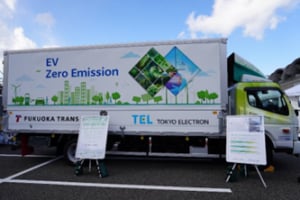
Source: Tokyo Electron BP
In fiscal year 2023, we actively promoted the use of reinforced corrugated cardboard packaging and modal shifts to achieve our annual sustainability goal set in fiscal year 2021. Reinforced corrugated cardboard is lighter in weight, which is expected to reduce CO₂ emissions during transportation. It is also recyclable and has a lower environmental impact than wood.
By fiscal year 2024, we had aimed to have a switchover rate from wooden crates to STW of 50% or above, but the actual switchover rate was 22.4%. We will work to standardize STW packaging and promote its use with customers. Additionally, we will extend the target achievement period for the fiscal year 2025 and promote our activities.
In fiscal year 2024, we carried out activities to achieve our annual sustainability goal of further promoting modal shifts and joint delivery and reducing CO₂ emissions from overall logistics (own delivery) by 30% (by fiscal year 2027). As a result, CO₂ emissions from domestic logistics were reduced by approximately 3 kilotons (18.4%) compared with estimated emissions had modal shifts and joint delivery not been implemented.
These initiatives were positively evaluated, and we and Tokyo Electron BP, a Group company, were nominated for commendation by the Director-General, Maritime Bureau, Ministry of Land, Infrastructure, Transport and Tourism in relation to the accreditation of the "Eco-ship Mark"*² for fiscal year 2023 organized by the Eco-ship modal shift business execution committee, as corporations that contribute to environmental measures through sea transportation, and were commended in May 2023.
Modal shift: Efforts to transform the means of transportation. Refers to the shift of transportation from car and air to rail and ship, which have lower environmental impacts.
Accreditation of the "Eco-ship Mark": The Eco-ship modal shift business execution committee organized by the Maritime Bureau of the Ministry of Land, Infrastructure, Transport and Tourism, and operators of ferries, RORO ships, container vessels, automobile vessels, etc. awards the "Eco-ship Mark" to cargo owners and logistics operators that contributed to the modal shift to marine transport, and the Director-General at the Maritime Bureau of the Ministry of Land, Infrastructure, Transport and Tourism grants an award every year to an operator that made a notable contribution.
Example initiatives
We are proactively promoting modal shifts to reduce environmental loads. In fiscal year 2023, we replaced more than 4,000 trucks used for transportation between Osaka and Fukuoka with ferries.
Tokyo Electron Miyagi has been making modal shifts to railways to transport components from suppliers in the Kansai district. In fiscal year 2023, they started to carry out modal shifts for transportation of components from suppliers in the Hokuriku and Kyushu districts. Because modal shifts will contribute to the mitigation of "year 2024 problems" that are expected to reduce the number of available truck drivers as a result of strengthening of overtime work regulations, we will continue to proceed with this initiative.
Resource-saving Initiatives
Because our products are precision equipment, they must be shipped with care and in clean conditions, requiring the use of wooden crates and cardboard boxes. To conserve some of these resources, We use recyclable cardboard boxes for packaging. After the equipment has been shipped and installed, casters and other specialized transport fixtures are collected and brought back to our factories for reuse. These are only a few examples of our resource-saving efforts.
Initiatives with Suppliers (E-COMPASS)
Example initiatives
We believe we must further accelerate our efforts to preserve the global environment and the "data-driven society," which will be a growing reality in the years ahead. To reinforce our partnerships with our suppliers, in March 2024, we held "TEL E-COMPASS Day 2024", a briefing session with all of our suppliers. At this briefing session, which was held using a hybrid approach, both online and in-person, we shared information about the progress we've made in our E-COMPASS activities and our net zero efforts. We also provided detailed explanations of environmentally-focused training materials, support plans, and more. This session, the third of its type, was attended by roughly 900 suppliers, of which roughly 70 attended in person, engaging in lively exchanges of information.
In December 2023, we awarded three of our suppliers the status of Environmental Partners at "TEL Partners' Day", in recognition of their tremendous cooperation with the activities of E-COMPASS. In April 2024, we also conducted the "E-COMPASS Survey" to confirm matters including the state of suppliers’ eco-friendliness with respect to the products they carry, the status of their products’ compliance with environmental laws and regulations, activities for reducing the environmental burden of their operations and more. Based on the results of the survey, in September, we plan to certify suppliers with an exceptional level of compliance with environmental laws and regulations and who are conducting excellent CO2 emission reduction activities as Green Partners as an expression of our feelings of respect and gratitude.
Achieving net zero by 2040 will require not only reductions in CO₂ emissions within Tokyo Electron but also cooperation in reducing emissions by our customers' and suppliers' production lines. We are engaging in discussions with some of our suppliers and fleshing out measures achieving these goals. We are also assigning persons in charge of net zero initiatives at each of our manufacturing sites and developing our internal systems.
We will work proactively to preserve the global environment across the entire supply chain through our partnerships with customers and suppliers.

